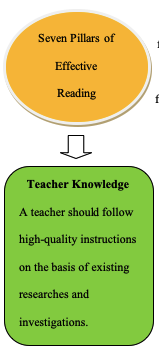Introduction
Reading is a vital skill necessary for successful studying. Reading is not simply the ability to recognize signs and know their meanings. It is a complex activity that requires attention, memory, knowledge of the language, and motivation. The acquisition of this skill may become rather challenging for students. The task of any teacher is to do everything possible to make the process of learning reading easy and pleasant. The role of the teacher should not be underestimated when it comes to teaching reading. A teacher is a coach who is expected to provide efficient guidance necessary for becoming a successful reader. In the following paper, a graphic organizer that categorizes the seven pillars of effective reading instructions will be created.
Graphic Organizer
Seven pillars of effective reading instructions may be regarded as a framework that guides the teacher’s activity in teaching reading skills. The teacher should rely on those pillars to choose the most efficient strategies for students to overcome reading challenges.
Teacher Knowledge
According to Reutzel and Cooter (2011), teachers should be aware of various approaches to teaching reading skills. I realize the significance of this pillar. My current practice in this area concerns following the Common Core Standards. Also, I read different kinds of research about helpful ways to improve the reading skills of students.
Assessment
In this area, I prefer following some of the practical recommendations suggested by Denton (n.d.). For example, I make notes on every student’s speed of reading and the number of words read in one minute. Also, I may ask children to explain the meaning of some words to check their comprehension and vocabulary (National Reading Panel, 2006).
Evidence-Based Instruction Practices
I always explain to the students the aims of the lesson and their responsibilities. Also, I believe that every classroom should have a library with printed materials for reading.
Response to Intervention
I divide children into small groups to meet their various needs. For example, one group includes those who have problems with skimming and scanning. This group will receive the task that is directly connected to the improvement of skimming and scanning.
Family and Community Connections
I communicate with parents of children and provide them with pieces of advice about the necessary monitoring of particular activities. Also, I recommend what home reading materials are most appropriate for the child.
Motivation and Engagement
I organize reading tasks in the form of plays or team works. For example, children have their roles in dialogues, and they should read them without mistakes and with proper intonation.
Technology and New Literacies
My common practice includes letting children use their smartphones to search for particular information on the Internet. Also, I may give them the link to the text and ask to find specific information.



Conclusion
Teaching reading may become a difficult task for any educator. Still, this skill is crucial for the further studying and academic accomplishments of students. Seven pillars of effective literacy educators form a guide for the proper organization of the learning process, providing differentiated instructions, and assessment of students’ achievements.
References
Denton, C. (n.d.). Classroom Reading Instructions that Support Struggling Readers: Key Components for Effective Teaching. Web.
National Reading Panel. (2006). Teaching Children to Read. Web.
Reutzel, D., & Cooter, R. (2011). Teaching Children to Read: The Teacher Makes the Difference. London, UK: Pearson. Web.